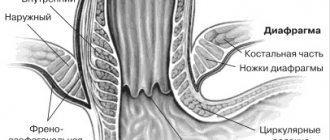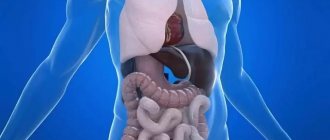Causes
Gastric hypotension can have a primary or secondary origin. Its causes are different: physical trauma, nervous strain, long-term mental trauma, sexual excesses, intoxication, metabolic disorders, infectious and mental diseases, long-term illnesses, hypokalemia. Gastric hypotenia can be detected by X-ray examination, using a gastrogram and electrogastrography.
Hypotonia becomes clinically significant if the loss of muscle tone continues for a long time. The lower the muscle tone, the larger the volume of the stomach. In healthy people, there is a well-known parallelism between the tone of the skeletal muscles and the tone of the stomach muscles. With a decrease in skeletal muscle tone, the tone of the gastric muscles also decreases. At the same time, there is a decrease in the tone of the bladder, sphincters of the intestinal muscles (flatulence develops, as, for example, happens in the elderly and the elderly).
Hypotension and atony of the stomach
We present to your attention an interview with a general practitioner, a doctor of the highest category, Zulfiya Ravilyevna Galimova, on the topic: “Hypotension and atony of the stomach.”
| Zulfiya Ravilyevna Galimova – general practitioner, doctor of the highest category |
We present to your attention an interview with a general practitioner, a doctor of the highest category, Zulfiya Ravilyevna Galimova, on the topic: “Hypotension and atony of the stomach.”
— What is hypotension and atony of the stomach? How are they related?
- One of the important functions of the stomach - peristalsis - is ensured by alternating muscle contractions of the organ wall. Thanks to these movements, food is mixed and crushed, the contact of food lumps with enzymes and other components of gastric juice involved in the digestion process increases, the contents move towards the pylorus towards the sphincter and are pushed into the intestines. To perform this work, muscle fibers must maintain tone and the ability to respond to reflex and neurohumoral signals. Gastric atony is a stable relaxation of the muscles of these organs, a complete or partial loss of tone in their walls. The pathological process in the stomach is expressed in the inability of the organ to perform basic functions, resulting in stagnation of food. Because of this, inflammatory processes in the gastrointestinal tract can develop, for example, gastritis, as well as impaired blood supply in the walls of the stomach.
Based on the severity of the disease, there are two degrees of atony: mild (hypotension) and severe. Depending on this, the patient may experience a variety of symptoms. Sometimes, even with a mild form, the symptoms are pronounced: for example, after a heavy lunch, the contours of the stomach can be visualized through a weakened abdominal wall.
Stomach hypotension is a rather unpleasant, but harmless disease. The pathology greatly worsens the patient’s quality of life, but with timely consultation with a doctor, it responds well to drug and non-drug treatment.
Gastric atony is a sudden weakening of muscle tone. The danger of the disease lies in the rapid increase in symptoms, up to the complete absence of muscle tone. Gastric atony is a very rare disease. Gastric atony develops against the background of serious illnesses, such as pneumonia or myocardial infarction. To understand the difference between atony and hypotension of the stomach and intestines, it is necessary to understand the symptoms of these diseases.
— What are the causes of the disease? What additional factors contribute?
— Causes of the development of the disease: congenital pathology of the organ, physical trauma, nervous overstrain, long-term mental trauma, sexual excesses, metabolic disorders, infectious and mental diseases, long-term illnesses, hypokalemia, disruption or death of nerve endings as a result of toxin poisoning, vascular thrombosis stomach, damage to nerve endings during surgery, regular overeating, leading to stretching of the walls. The causes of the disease may be hidden in sudden weight loss due to stress or anorexia. In the latter case, the functioning of the entire gastrointestinal tract is destabilized. Symptoms of atony tend to progress, becoming severe.
Additionally, they are provoked by improper monotonous nutrition, asthenic (thin) constitution, age, impaired bile motility, long-term use of certain medications, and a sedentary lifestyle.
— How does hypotension and subsequently gastric atony develop? What processes occur in the body?
— The mechanism for the development of gastric atony in eating disorders is the constant irritation of the receptors of the pyloric part of the stomach with coarse, insufficiently crushed food, toxins and extractive substances. The development of the pathological process in severe general diseases is complex and usually includes a violation of both secretory and motor functions, which ultimately leads to gastric paresis. Pathology of the central nervous system and endocrine system can lead to disruption of the production of hormones that regulate the functioning of the gastrointestinal tract.
- What are the symptoms? When to see a doctor?
— The symptoms of the pathology are nonspecific and are inherent in most other diseases of the stomach and intestines. Patients complain of a feeling of pressure and heaviness in the epigastric region, distension in the stomach. Abdominal pain may occur. Characterized by heartburn, nausea, belching large amounts of air and food, and bad breath. Vomiting of a large amount of liquid contents mixed with greens is periodically observed. Characterized by rapid satiety after the first portions of food. With acute dilatation of the stomach, the patient is pale, covered in cold sweat, and experiences tachycardia and arterial hypotension.
Upon examination, one can see a bulging in the projection of the stomach, a splashing noise upon palpation. When percussing (tapping) over the stomach, a characteristic “drum” sound (tympanitis) is heard. The borders of the stomach are significantly expanded to the right and down. When a gastric tube is inserted, the liquid contents are very quickly evacuated from the stomach, bringing significant relief to the patient. If the patient is not helped in time, circulatory problems begin in the wall of the stomach, and it may rupture. Stagnation of contents in the stomach often leads to gastritis.
— How is the disease diagnosed?
— The main method for diagnosing hypo- and atony of the stomach is gastrography or endoscopic examination of the gastrointestinal tract (esophagogastroduodenoscopy). An X-ray with contrast shows a picture characteristic of this disease: the contrast, entering the esophagus into the stomach, is immediately sent to the bottom of the stomach. Peristalsis of the stomach walls is usually significantly reduced. Due to atony, the stomach takes on a vertically elongated shape with a significantly lowered bottom and a characteristic “waist”. Contrast evacuation is slowed down; its residues can be detected in the stomach more than six hours after the start of the study.
With endoscopy, a significantly expanded gastric cavity is visible, filled with a huge amount of stagnant contents. The folds of the mucous membrane are preserved, but peristalsis is significantly weakened. When performing an endoscopy, intragastric manometry is possible, which helps to identify paresis of the gastric muscles. Electrogastrography records low waves with large intervals. Any functional disorder is characterized by great diversity and variability of the electrogastrographic pattern over a short period of time.
The disease should be differentiated from other gastrointestinal pathologies. If nausea and vomiting are accompanied by dizziness, hearing loss and tinnitus, Meniere's syndrome should be excluded. Repeated vomiting without weight loss or deterioration in general condition may be psychogenic. If after vomiting the abdominal pain significantly weakens or goes away, this may be a sign of a stomach ulcer. Acidity in gastric atony is usually normal or moderately increased. If there is a significant increase or decrease in the pH of gastric juice, you should think about other diseases.
— What is the standard of treatment? Could surgery be required?
— Patients with this rare pathology should be closely monitored by a gastroenterologist, a specialized specialist (who treats the underlying disease), a psychotherapist, a nutritionist and a physiotherapist. First of all, after making a diagnosis, a thick gastric tube should be inserted and all its contents should be evacuated to prevent gastric rupture. Active attention should be directed to treating the underlying disease.
Drug treatment includes drugs that improve gastric motility, vitamins and restoratives. If the disease develops against the background of severe asthenia, then anabolic steroids and hydrolyzed proteins are prescribed. Drugs that stimulate tissue repair are also indicated. For moderate hypotension, potassium and calcium supplements can be prescribed, and for severe hypotension, neostigmine can be prescribed.
The need for surgical treatment arises only when there is a threat of complications (threat of gastric rupture)
— What diet is prescribed for the disease?
— The patient is prescribed a therapeutic diet (table No. 2): food should be liquid and easily digestible, divided into 7-10 meals a day in fractional portions. The diet includes a large amount of fiber and vitamins. You should also drink little by little in small portions.
— What recommendations can be prescribed to the patient after the disease has been cured?
— The course of gastric atony is usually long-term and recurrent. Acute dilatation of the stomach during myocardial infarction, pancreatitis, peritonitis and thrombosis of gastric vessels can be fatal. To prevent the disease and its relapses, sanatorium-resort treatment in a sea or mountain climate, moderate physical activity to increase general tone and strengthen the anterior abdominal wall, and treatment with mineral waters are recommended. Failure to adhere to the correct daily routine and diet, smoking, and drinking alcohol aggravate the course of the disease and provoke its relapse.
Interview prepared by: Maria Zelenskaya, Head of Public Relations of the Association of Medical Journalists, Chief Editor of the Digest of the Academy of Obstetrics and Gynecology magazine
Symptoms
Patients complain of fatigue, absent-mindedness, rapid onset of physical and mental exhaustion, poor sleep, flatulence, rapid satiety, and constipation. Appetite is often normal, rarely increased. Dyspeptic symptoms are not always observed. Vomiting is extremely rare. Sometimes there is a protrusion in the epigastric region due to food retention in the stomach.
If gastric hypotension continues for a long time, the patient loses weight, becomes lethargic, and depressed. At this stage, gastric hypotension is usually complicated by changes in its mucosa.
Gastric hypotension is manifested by weakened peristalsis and slow gastric emptying (up to 6 hours).
It is noteworthy that rest and bed rest worsen the patient’s well-being. Moderate physical work, sports, walks, music have a beneficial effect. Mitigation of functional disorders of the nervous system leads to an increase in the tone of the gastric muscles. If this is not observed, you need to think about the organic nature of gastric hypotension. With hypotension of the stomach, its fundus is expanded, lowered to one degree or another, and symptoms of a neurotic state are observed.
Reasons for the development of the disease
Cardiac sphincter insufficiency is quite common
The disease can appear as a result of a wide variety of factors:
- unhealthy diet, overeating;
- obesity;
- diseases of the stomach, in particular gastritis, ulcers, tumors, hypertonicity of the stomach muscles);
- eating before bed;
- low mobility;
- hiatal hernias;
- pyloric spasm;
- increased intra-abdominal pressure that appears during pregnancy, ascites;
- increased pressure in the stomach;
- operations accompanied by sphincter resection.
Intra-abdominal pressure can develop as a result of heavy physical labor and heavy loads. From overwork, hiatal hernias appear. This can also provoke pathology.
Treatment of gastric hypotension
For gastric hypotension, a regulated lifestyle is recommended: sufficient sleep (7-9 hours), walks in the open air for at least 3-4 hours, labor regulation (physical labor), physical therapy, sports, massage, giving up alcoholic beverages and smoking.
Food should be taken 4-5 times a day in a calm environment. You need to eat slowly, chewing your food well. The diet must be enriched with B vitamins and vitamin C, fresh dairy products (milk, cottage cheese, kefir, cheese, lean meats, fresh vegetables, fruits. Beans (rich in phytic compounds) and leafy greens are recommended: lettuce, spinach, cauliflower, celery, parsnips, wheatgrass. The amount of liquid in the diet is moderate. Constipation should be eliminated with distic measures (yogurt, kefir, boiled beets, strong decoction of prunes, grape juice, carrot juice. Laxatives and enemas should be avoided. Hydro procedures have a good tonic effect: rainwater or a fan shower, morning rubbing with water at room temperature followed by a light massage, walking with a gradual increase in distance, strengthening the abdominal press. Rest in a village or a rest home is recommended.
Treatment
Gastric atony is treated quickly and effectively
In case of gastric atony, it is not recommended to perform surgical intervention in its area, but to be guided by taking special medications, following a special diet and undergoing a course of physiotherapy. A whole group of specialists is involved in the treatment of gastric atony, including a physiotherapist, gastroenterologist, nutritionist and psychotherapist.
Having confirmed the diagnosis of the development of this disease in the body, the patient is given a gastric tube to remove food debris from the area of this organ in order to prevent ruptures in its walls. The patient is recommended to follow a special diet based on liquid and light foods taken in small portions up to seven times a day. The food you eat should contain an increased amount of plant fiber and the maximum number of various vitamins.
Patients with gastric atony are prescribed medications that help restore gastric motility. Also, people suffering from this diagnosis are advised to limit the body from excessive worries and stress. Compliance with all recommended standards will help restore the muscle tone of the stomach and promote a speedy recovery of the entire body.
Diagnosis of hypotension:
The easiest and fastest way is to measure blood pressure using a tonometer (currently there are universal devices with AFIB technology that can simultaneously measure blood pressure levels and detect atrial fibrillation). Diagnosis of arterial hypotension is a complex measure that includes:
- Daily blood pressure monitoring - the patient’s blood pressure is measured after a certain period of time and its fluctuations are determined;
- Biochemical blood test (diseases of the heart, blood vessels, endocrine system are confirmed or excluded)
- Electrocardiogram
Causes of hypotension
The causes of hypotension are multiple, since a decrease in blood pressure can occur in a variety of physiological and pathological conditions of the human body.
Leading causes of arterial hypotension:
- Neurocircular dystonia
- Pronounced stress
- A number of diseases:
- Massive bleeding, dehydration
- Sudden cardiac dysfunction
- Vitamin deficiency (deficiency of vitamins B, C, E is especially dangerous)
- Exhausting diets
- Taking certain medications
Dumping syndrome after gastric resection; Myocarditis, cardiomyopathy, arrhythmia, heart failure; Polyneuropathy (due to diabetes mellitus); Hypothyroidism; Diseases of an infectious nature; Benign and malignant tumors







